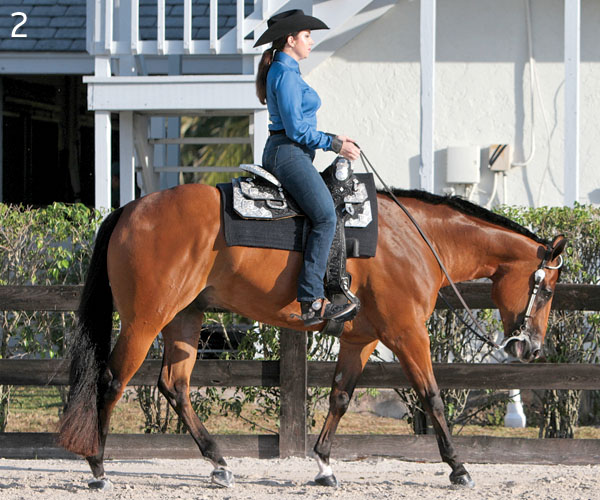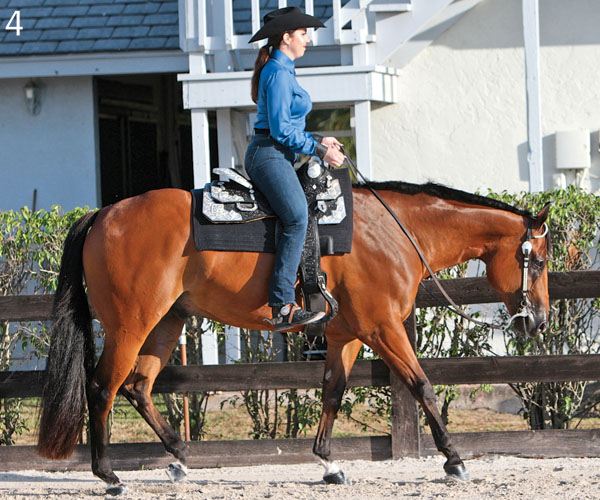Riders hate to hear it, but trainers and coaches keep saying it just the same: “Drop your stirrups.”
While you might not like the soreness the day following the stirrup-free session, you can’t deny the practice is good for you. I have my riders go without stirrups on a regular basis for a few reasons. First, it builds leg strength. If you can hold your position without stirrups for an extended time, it’ll be even easier to stay in position with stirrups. Second, riding without stirrups does wonders for your stamina in the saddle. Third, the confidence boost you get from knowing you can maintain your position at all gaits without stirrups is second to none. Finally, this practice improves your connection to and communication with your horse.
Here, I’ll go over a few pointers to help you make the most of your stirrupless riding sessions. The model rides one-handed, but you can ride with two if that makes you more comfortable. Just be sure you don’t balance on your hands and put extra pressure on your horse’s mouth.
1. Before you drop your stirrups, put in a solid warm-up. Work at all gaits to capture your horse’s attention and fine-tune your body position while your feet are still secure. Work in both directions on straight lines, circles of varying sizes, serpentines—whatever it takes to get yourself confident and ready, and to get your horse focused on you and what you want to work on. If your horse is having a particularly rough day, then postpone the stirrup-free work until your next training session. A lack of readiness on your or your horse’s part will only set you up for frustration. But don’t make it an excuse. If your horse just needs a little more time to get in the groove, then give it to him and then move into these exercises.

2. This rider has a strong leg and solid position. If you don’t look closely to see that she’s dropped her stirrups, you can’t tell much difference in her body and legs between this and the first photo. Her core and body are squarely over her base, her heels are down, and her toes are forward. Plus she���s not balancing on her hand—that is, using the reins and pressure on the horse’s face to keep her balance. This position is the goal. When you first start out, you’ll have to readjust regularly, ensuring that your legs are underneath your hips, your feet aren’t out in front of you, and your torso doesn’t tip forward or backward. Start at the walk, then progress to the jog. Once you’re fully confident in your strength, try it at the lope. Done properly and with practice, this will become as easy as riding with stirrups.

3. Advanced riders work without stirrups at extended gaits, as shown here. Just as she would with her feet in the stirrups, the rider uses her leg pressure and verbal cues (clucking) to drive the horse forward as she begins to extend her horse’s stride at the jog. Notice that her leg position hasn’t moved—her legs are squarely below her base. However, her torso is tipped slightly back. Ideally, she’d keep her core perpendicular to the ground, just as she would with her feet in the stirrups. If her lean was more exaggerated, she could lose her balance and push her legs out in front of her, which would put her completely out of balance.

4. When you’re really ready to challenge yourself, attempt to “stand” in your saddle—without stirrups. Yes, it’s possible, as the rider demonstrates. She pushes her hipbones forward toward the pommel of the saddle and uses her inner thighs to lift her seat. She’s careful not to lean forward. That would push her feet behind her and leave her out of balance. Look closely and you’ll see that her leg position still hasn’t changed. She’s built strength by regularly practicing these exercises. When you’re ready to try this one, do it in short increments first, holding the position longer as you build more strength. It’s the one that’ll really test how far you’ve come as you practice the other exercises discussed here.

Patty Vatterott, Wellington, Florida, is a lifelong horsewoman who now focuses on coaching and educating amateur and youth riders to success in all-around events. Learn more at searidgefarms.com.
Save






